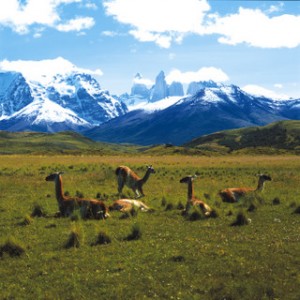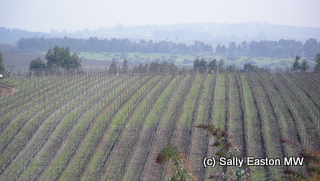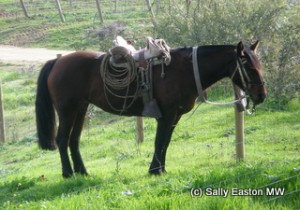Cool climate wines in Chile
This article was first published in The Drinks Business, September 2008.

Llamas in Patagonia
Viticultural Chile is moving at a pace that would pride a troop of triffids. In a country where more than 40% of the vineyard area is less than 10 years old, new valleys, outside the preserve of the Central Valley, are being explored in the quest for cooler climate Chile.
But ‘normal’ climatic rules no longer apply. Chile may be that long, skinny country 4,200km from north to south and only 100km west to east, but Diego Benavente, winemaker at Matetic Vineyards, in San Antonio valley said “people say Chile is wider than it is long because the climate changes more dramatically east to west than it does north to south.” Marcelo Papa, Concha y Toro’s head winemaker drummed home the point: “In Chile 10 to 15km east to west can make the equivalent change of 400km north to south.”
So while Elqui to Bio-Bio is more than 1,000 km distant, it’s time to forget the north-south divide, and rethink Chile in terms of east and west, as well as low and high altitude.
Fogs and ocean breezes
In many parts of the world, MJTs (mean January (southern hemisphere)/July (northern) temperatures) and degree days remain a useful starting block from which modifications and refinements can be made to identify climate zones. But the indefatigable Marcelo Retamal, climate and soil expert as well as De Martino’s chief winemaker, said “For me it’s most important to recognise the warm areas in the world using the average of the maximum temperature.” The mean temperature works, he said, but the high diurnal temperature variation in all parts of Chile is important.
The Humboldt current drives part of this, coming up from the Antarctic, bringing chilly winds. Ocean influence is crucial and is often a combination of fog, near the coast, and ocean breezes, which can reach quite far inland, where transverse valley topography allows.
Much of San Antonio Valley, on the west side of the coastal ranges, is open to direct ocean influences. Viviana Navarrete, the winemaker at Viña Leyda, 13km from the coast, said they have “mist and fog the whole year which stays till noon. Then breezes push the clouds away and we get sun in the afternoon, which allows us to ripen with freshness.”
Freshness is an important issue for these producers. Francisco Ponce, winemaker at Viña Garcés Silva, which produces the Amayna brand, said they feel the “cool climate in the acidity of grapes. Here we don’t lose the acidity, it’s still at a good level.”
San Antonio is colder, windier and foggier than Casablanca. As well as general coolness, we return to the diurnals. Benavente said: “the difference between day and night is sometimes more than 20°C. Polyphenols evolve slower with high diurnals, we have to wait for them to ripen. There’s not much metabolism at night.” Even though viticulture is less than 10 years’ old, the valley’s suitability for sauvignon blanc, chardonnay, pinot noir and some interesting early examples of cooler climate syrah have become evident.

Casablanca Valley
At just over 20 years old, the grand old dame of Casablanca, also on the ocean side of the coastal ranges, is these days regarded as a rather large and diverse region, erring towards 50km across, which is in fact notably warmer at its east end than its west end, given the latter’s greater proximity to those cold Humboldt breezes. Additionally the fogs, which provide temporary respite from the sun, do not reach the east end of the valley, and a temperature gradient of up to 4°C has been observed between the west and east of Casablanca, with the east end harvesting up to three weeks before the west end.
Luminosity
One thing the fog does is to reduce the level of luminosity. Benavente, in foggy San Antonio, said: “there’s less luminosity here. We’ve planted mostly north facing slopes to get more sun. In the ripening season say we get 3 to 4 foggy days a week.” The downside, he added, was that “too strong an ocean influence is detrimental to flowering and yields.”
Luminosity is all about the amount and intensity of light, independent of temperature. It’s great for photosynthesis. According to self-declared non-expert on the subject, Aurelio Montes, chairman, founding partner and winemaker of Viña Montes, “most grape varieties would love some luminosity for colour, phenols and tannins. It’s found more in high level altitude, where humidity is low.”
He added “luminosity is not temperature – mountains can be freezing, but with high luminosity.” (sunburn on the ski-slopes?). Retamal addresses this apparent paradox of sunburnt grapes and cooler climate: “UV is part of luminosity. Limarí is cool climate in terms of temperature, but we have light, and the grape skins can get sunburn. We’re changing rows to east-west. If rows are north-south, both sides of bunches burn. If they’re east-west, the idea is the sun crosses over the row. We need to cover fruit with leaves.” At De Martino’s Quebrada Estate, which is 24km from the ocean, he said “this year we decided not to use wires with VSP [vertical shoot positioning]. We let the shoots fall down [for shade], and we had no burn problem. We picked three weeks later, the wine had 13.6% alcohol, the acidity was very good, the pH was good, the wine is outstanding.”
The Limarí valley is making a name for both chardonnay and syrah. Concha y Toro’s Papa explained their Maycas del Limarí project: “Limarí is affected by the ocean. The coastal ranges do not exist [so plenty of wind]. But Limarí is quite extensive, there are some warm parts. In the area we’re growing, the maximum average January temperature is 25°C, the minimum average 12°C.” He said this roughly compares to Puligny Montrachet, but the length of time over which the peak of temperature extends is longer in Limarí, which is important. Chile’s high alcohols are partly explained where the average maximum extends for several months. Compare this to Bordeaux for example, where it extends for just one month.

Parked just outside the winery
Further north still, despite a little closer proximity to the equator, Elqui Valley still has cool bits. De Martino own Chile’s highest vineyard at 2,000m ASL in Elqui, a region probably more famous for having some of the best quality light on the planet, to which several observatories attest. They’re using a new-to-winemaking training system, the parrón Elquino, a variant of the pergola, where a single long branch, angled at something approaching 45°, is trained at height to provide shade against sunburn. The system was originally created for local people who produce grapes for Pisco, and who know a thing or two about grape growing in the region.
Andean altitude
Moving over to eastern influences, the Andes also play their part in moderating temperature, in the foothills, offering a slightly cooler spot in an otherwise warmer area. As such it’s better suited to later ripening varieties, so while cabernet sauvignon is frozen out of the ocean coast, it finds succour in the Andean foothills. Cabernet sauvignon ripens late. It needs warmth to avoid herbal notes, so cool for cabs is more likely to be a cooler spot in a warmer clime. Andes and altitude rather than ocean and aeolian influences.
On the subject of cool climate cab, Montes said: “it doesn’t work in Casablanca, Leyda, and Limarí. There’s too much minty, eucalyptus and pyrazine flavours. But cool climate cabernet sauvignon is found in the Upper Maipo and foothills of Colchagua at 500 to 650m altitude. Over 700m is too cold. ”
Pérez Cruz takes advantage of just such a foothill spot, being 50km south east of Santiago in Maipo Alto, at altitudes of 480 to 520m. Their winemaker, Germán Lyon said: “it’s not a cool area, it’s warmer than Bordeaux, but it’s not too warm. The south east spot of Maipo is cooler than Colchagua for example. The vineyards are the first to be cooled by the Andes at night, and the last to be warmed during the day by ocean breezes. The day-night temperature variation is 18-20°C.” For late ripeners such as cabernet sauvignon, the trajectory continues to be finding cooler spots in the general warmth.
Antarctic latitude
Way down south towards the cooling Antarctic, Bio Bio valley is recently oft-touted for aromatic grape varieties such as riesling, gewürztraminer, even pinot noir. But disease pressure becomes more of an issue. Rainfall increases as you go further south, more than 1,000mm in the Bio Bio to over 2,000mm at Puente Montt, south of Malleco Valley (which isn’t as far south as Marlborough in New Zealand).
But there’s that east-west effect again. Retamal explains: “It is the proximity to the ocean that will determine whether the climate is cool or not. If you are close to the ocean or next to the canyon of a river where you can sometimes experience cooler breezes, you will be in a ‘cool climate’. However, if you are close to Los Angeles, the main town in the region, the likelihood is that you will be in a warmer climate, since this middle area of Bio Bio generally records peak summer temperatures that push 33°C – warmer than Santiago.”
So, with apologies to Germany: thought you knew Chile – think again.



